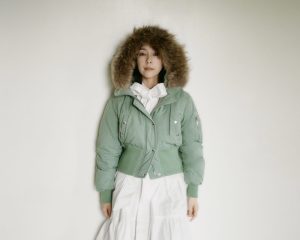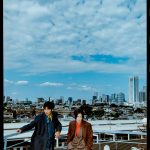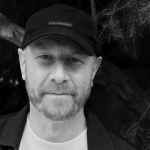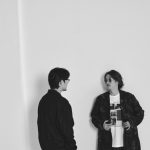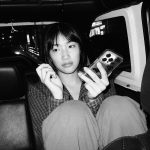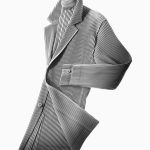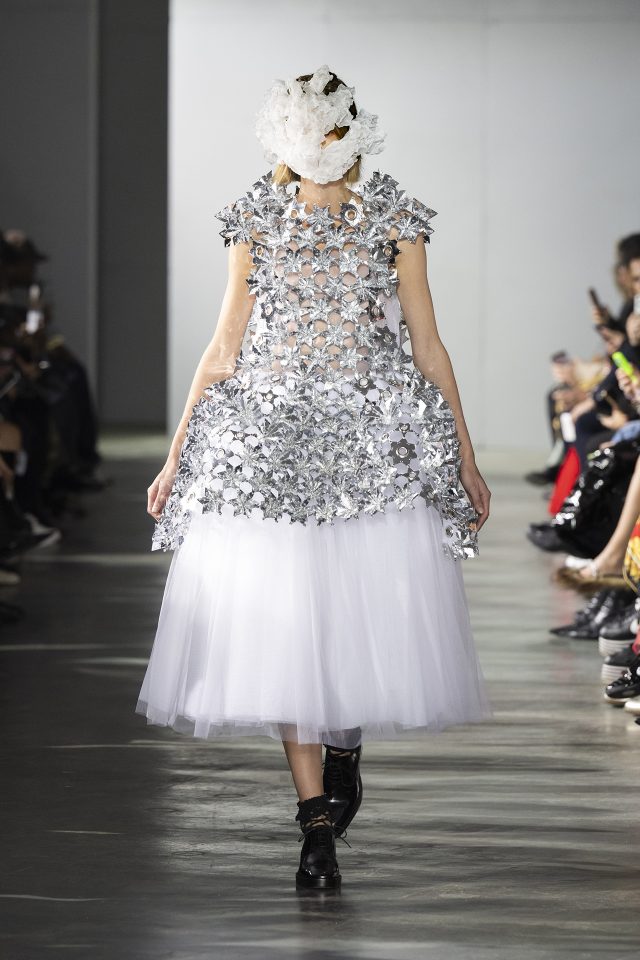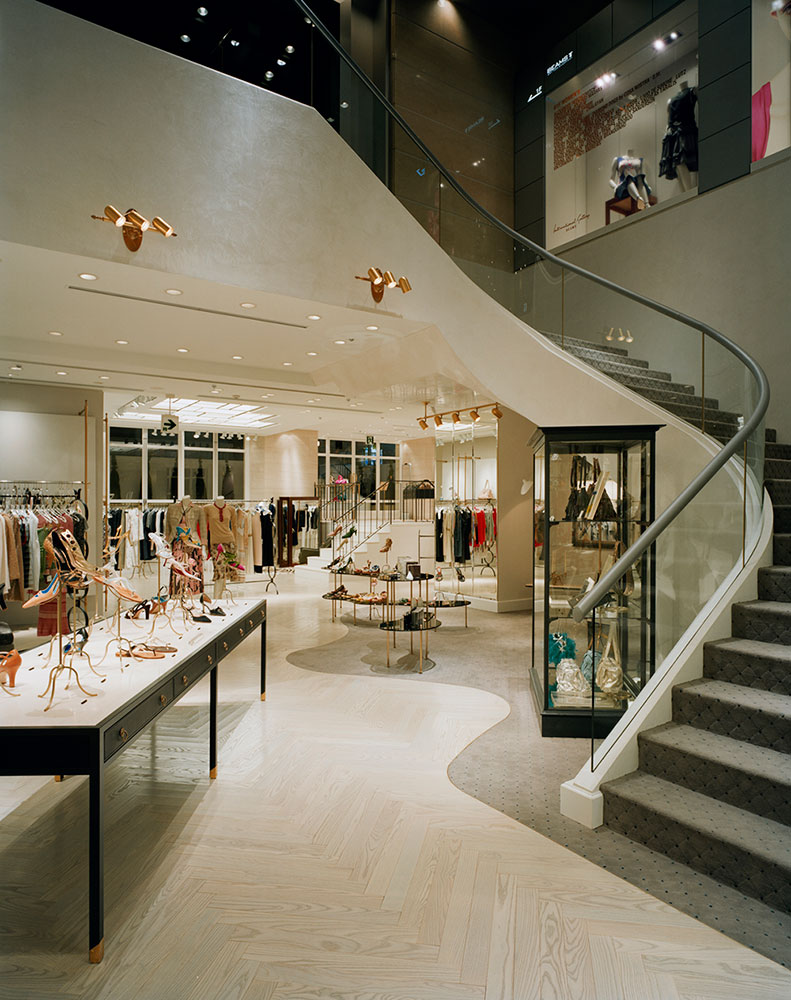BEAMS (ビームス) 代表取締役、設楽洋インタビュー
Yo Shitara
BEAMS の創業者・設楽悦三氏の息子であり、現 CEO である設楽洋氏に時間をいただき、原宿の小さな1号店から海外展開の話まで、過去40年の歴史を聞いた。
BEAMS (ビームス) 代表取締役、設楽洋インタビュー
Portraits
*You’ll find the English text after the Japanese.

BEAMS beyond TOKYO
1976年に設楽家が原宿の閑静なエリアの一角にオープンさせた、6.5坪のインポートショップ「American Life Shop Beams (アメリカンライフショップ・ビームス)」。41年がたった現在、BEAMS (ビームス) は日本を代表するセレクトショップとして確固たる地位を確立している。国内外に約160店舗を展開しながら約30のレーベルを抱え、独自の目線で編集したファッション、アクセサリー、ライフスタイルグッズを幅広い年代の男女に向けて提案する最重要セレクトショップのひとつだ。
BEAMS のストーリーは、ただ単純な会社のサクセスストーリーではない。「日本のファッション業界全体の成長を理解する上で欠かせないストーリー」といっても過言ではないだろう。カリフォルニアの学生の部屋をコンセプトにした、ファッションを軸としたライフスタイルグッズの取り扱いからスタートした BEAMS はその後、米国東海岸のプレッピースタイル、イタリアのスーツ文化、ロンドンのストリートファッションを日本に紹介。Paul Smith (ポール スミス) や Giorgio Armani (ジョルジオ アルマーニ)、Alden (オールデン) などといった海外ブランドを日本に初めて持ってきたショップでもある。
近年ではアジアでの店舗展開やカナダ・バンクーバーでのポップアップショップなど、海外市場にも積極的なBEAMS。今年2月には、100件以上にもわたる他社ブランドとのコラボレーションを紹介したビジュアルブック『BEAMS beyond TOKYO』を、ニューヨークの出版社 Rizzoli (リッゾーリ) から発行している。革新的な製品を世界各地からバイイングし、完璧なプレゼンテーションを店舗で行う BEAMS の並外れたパワーを目にする機会は、ますます増えていると言えるだろう。
今回、BEAMS の創業者・設楽悦三氏の息子であり、現 CEO である設楽洋氏に時間をいただき、原宿の小さな1号店から海外展開の話まで、過去40年の歴史を聞いてみた。
-創立当時の話を聞かせてください。BEAMS の創立以前は東京で欲しい洋服を買うのは難しかったのでしょうか?
難しかったですね。僕は1951年生まれで今年66歳になりました。初めてテレビが来た日も覚えてますし、テレビで見たのはアメリカの映画やホームドラマでした。そこで目にするファッションやライフスタイルを買うところが当時はまったくなかったんですね。学生時代に買うところといえば、百貨店か町の小さな洋服屋さんぐらい。インポートのモノを買おうと思うと、すごく高いスーパーブランドか、アメ横や横須賀の米軍放出品いわゆる軍モノと言われているミリタリーの古着しかありませんでした。気軽にカジュアルでオシャレなもの買うことができない時代でしたね。
-アメ横にはよく行かれたんですか?

Photo by Hiroki Watanabe
行きました。僕らの学生時代というのは、ちょっと上の世代が学生運動をやっていて、学校が封鎖されてしまい授業に出たくても出られない。そんな時代でした。なので天気が良い日は、よく湘南の海に行っていましたね。そこでベースキャンプの高校生や大学生と友達になって、年に何回か米軍キャンプのバザーに入れてもらったんです。そこには自分たちが憧れていた、テレビで見たアメリカの世界がありました。白い住宅の中に大きい冷蔵庫があって、外のバスケットリングの下で子供たちが遊び、見たこともない白いジーパンを履いていたり、格好良いスニーカーを履いていたり。当時はそういうのを欲しいなと思っても買うところがなかったんですね。バザーでたまに出ますけど、サイズが大きくて買えない。そういうものを探しにアメ横だとか横須賀だとか福生だとかに行って探しに行くんですが、あるものはだいたい軍モノのお古。カジュアルな普通のものがありませんでした。
-湘南でサーフィンされていたと思いますが、当時のサーフィン文化は、直接カリフォルニアに憧れがあったんですか?
ありました。僕らの時代というのはとても単純で、男の子はほとんどアメリカに憧れて、女の子はパリに憧れていました。当時はなかなか海外に行けなかったんですね。ドルも1971年までは360円の時代でものすごく高かったです。学生の時のテレビのクイズ番組で「さあ、夢のハワイへ行きましょう」みたいな (笑)。ハワイですら夢の時代でした。中学生、高校生の頃に The Beatles (ザ・ビートルズ) を聴いて衝撃を受け、皆がジーパンを履いてギターを持つという世代ですから、テレビ、映画、雑誌で見るアメリカのキャンパスライフにすごく憧れていましたね。その経験をして、学生時代に一生懸命バイトをしてお金を貯めて、はじめて海外へ渡れる機会ができました。
-1970年代のある日、お父様 (設楽悦三) が帰ってきて原宿で洋服屋さんを始めるというのを聞いて、当時どう思われましたか?
ビックリしましたね。親父はもともとダンボールのパッケージの会社をやっていたのですが、1970年代中盤にオイルショックがあって紙の値段がものすごく上がってしまったんです。もちろんダンボールの値段も上がり、輸送箱に付加価値を付けるのは難しく値段の勝負になってしまいました。このまま行っても会社の将来は難しい。親父はぜんぜんファッション系ではなかったんですが、オシャレは大好きでした。それと若い人たちと飲むのがとにかく好きで、よく新宿を飲み歩いてました。そういったところから、今ままでは付加価値の乏しい輸送箱を作っていたけれども、今度は付加価値のあるものをやろうということでファッションをやりたいと相談されたんです。ただ単純にファッションというだけではなくて、アメリカの欲しいと思っても買えないものを扱おうということになりました。BEAMS は1976年の2月にオープンしたのですが、その夏に初めての情報誌『POPEYE (ポパイ)』が創刊されました。それまでは『an・an (アンアン)』や『MEN’S CLUB (メンズ クラブ)』といったファッション誌はありましたが、どこに何が売っているかといった情報誌ではありませんでした。当時、自分も含めた若者はとにかくモノと情報に飢えていました。知りあいの人に「アメリカで“ニケ”(Nike) って運動靴が流行ってるみたいよ」と言われて「じゃあ“ニケ”探しに行こう」というぐらい情報がなかった (笑)。今のようにネットも携帯電話もない時代でしたので、何かを欲しいと思った時はそれを知っていそうな人を探すところから始まるんです。そういう人を一生懸命探して、その人にどこで買うことができるのか相談する。そしてその情報をもとに探し回る。結局ほとんどないんですけれど、たまに見つけるとすごく嬉しかったですね。
-当時の原宿はどういうイメージでしたか?

© 原宿表参道欅会
BEAMS がオープンした当時の原宿はまだほとんどお店がありませんでした。いま Laforet (ラフォーレ) があるところは教会でした。そして表参道の先の半地下のところに BIGI (ビギ) の最初のお店ができて、竹下通りには2軒しかお店がありませんでした。

© 原宿表参道欅会
それからいまの原宿セントラルアパートに小さいお店があって、それからキラー通りの方に NICOLE (ニコル) の最初のお店、HOLLYWOOD RANCH MARKET (ハリウッド ランチ マーケット) の前身の極楽鳥というお店、そして BEAMS があるという状況でした。それまで若者の風俗、文化が生まれる街というのは夜の世界だったんです。六本木や赤坂とかね。そのさらに前は昼の世界で、銀座の「みゆき族」という世代。でも当時のおしゃれな人たちは、ディスコ、バー、ジャズ喫茶といった、夜の世界に集まっていました。それは時代を凄く反映していましたね。学生運動もあったし、アメリカもベトナム戦争の時代でしたから。世界中が昼の健康的な文化ではなかった。音楽もソウルやジャズといった、夜に聴くもの。時代がちょっと前だったら、BEAMS は新宿、赤坂、六本木辺りにオープンしてたかもしれない。
でも BEAMS がオープンする直前から、日本の学生運動が終わりアメリカも戦争が終わり、いわゆるヒッピー文化から西海岸ブームに入りました。なんとなく昼の風が吹いてきて、音楽も突然、カリフォルニアサウンドの“軽い明るい空”みたいなになりました。BEAMS がオープンした1976年の大ヒットは Eagles (イーグルス) の『Hotel California (ホテルカリフォルニア)』ですから。それまで夜遊んでいたおしゃれな人たちがセントラルアパートやレオンという喫茶店に集まり始めて、サーフィンだとかスケボーをやり始めるなど、急にトレンドが変わりました。

© 原宿表参道欅会

© 原宿表参道欅会
なので、当時 BEAMS をどこのエリアでやるかというと「原宿」しか考えられませんでした。そしてオープンの一年前に開店の準備をしていた頃、『made in USA catalog』(読売新聞社) という本が出版されました。当時のアメリカン・ライフスタイルを伝えたカタログ雑誌なのですが、衝撃的でショックを受けたと同時に、自分たちがやろうとしていることは間違いないと思ったんです。その『made in USA catalog』のスタッフがマガジンハウス (当時の平凡出版) に移って創刊したのが『POPEYE』です。そして第一号の特集が「カリフォルニア特集」。世の中の流れが自分たちが考えている方向になってきたと感じました。
-当時、原宿で洋服の店をはじめるというのはかなり画期的だったと思いますが。
最初は洋服のお店だと思っていませんでした。BEAMS の看板の上には「AMERICAN LIFE SHOP BEAMS」と付いていました。当然洋服もありましたが、自分たちが憧れていた「アメリカの生活」を売るお店でした。自分たちが見てきた UCLA (カリフォルニア大学ロサンゼルス校) の学生部屋のように狭いお店でしたので、学生の部屋のようにして、学生の部屋にあるものを置きました。真ん中にパインのテーブルを置いて、その上にローソク立て、スケボーのホイール、ネズミ捕り、お香なんかを置いていました。それと壁側に T シャツ、スニーカー、ジーンズを置いて、学生の部屋そのものでした。1990年代くらいから「これからはライフスタイル提案だ」と世間的にも言われるようになりましたが、BEAMS は1970年代から一貫してライフスタイルショップをやろうとしていたんです。そして T シャツ、ジーンズ、スニーカーなどが売れだして、売れたら買い出しに行くというスタイルで洋服が徐々に多くなってきて洋服屋さんみたいになっていきました。

オープン当時のBEAMS
-インポートショップを始められて当時リスクもあったと思うのですが、成功したなと実感できたのはいつ頃でしょうか?
最初は全然売れませんでした。ただ当時、出始めのスタイリストや雑誌の編集者、セントラルアパートでマンションメーカーと言われていた BIGI や NICOLE のファッションデザイナーなどが、原宿に BEAMS という面白いお店があると広めてくれたんです。一般の人にはほとんど知られていなかったし、広告宣伝もできない。そういう人たちの口コミからだんだん広がっていきました。当時、初任給が6万円くらいの時代に5万円くらいの靴を売ってましたから、よほど洋服が好きな人でなきゃ買えないし、お金持ちはスーパーブランドに行ってしまう状況でなかなか売れませんでしたね。そして1970年くらいに『POPEYE』が後押ししてくれてようやく一般の人たちが来てくれるようになりました。いけると確信したのは、1979年あたりのロゴトレーナーのブームです。いわゆるプレッピーブーム。「boat house」「SHIPS」「Crew’s」などのロゴトレーナーを街中のみんなが着ていたときにものすごく売れました。自分たちが UCLA のライフスタイルとして売ってきたものが、街中のブームになったんです。ただ店の売上げの半分がそれでの売上げになってしまって、止める決断をするのにものすごく葛藤がありました。止めると売り上げ減ってしまうが、このままいくとキャラクターショップになってしまう。後から考えれば、止める決断をできたからこそ BEAMS が残っていけたのだと思います。
-International Gallery BEAMS (インターナショナル ギャラリー) はそのあとに作られたのでしょうか?
そうです。このままではダメだという思いがあったので International Gallery BEAMS を作ることができた。最初、世の中の流れが東海岸のプレッピーブームに移り、BEAMS F (ビームスF) というプレッピースタイルのレーベルをスタートしました。さらにそのルーツがヨーロッパにあるということで、現地に行って International Gallery BEAMS をオープンしたんです。BEAMS はビジネスを前提に考えるのではなくて、流れがどちらに行ったかということを基準にお店を増やしていました。ただ当時 International Gallery BEAMS を始めたときは、ぜんぜん売れませんでした。今となっては誰もが知っている世界的なブランドがたくさん並んでいましたが、当時は知っている人が少なかったですから。

1990年代の International Gallery BEAMS
-Armani (アルマーニ) や Paul Smith (ポール スミス) もそうですよね。
そうです。International Gallery BEAMS という名前をつけちゃったので、当時は皆さんお店だと思わずギャラリーだと思って、眺めるだけで帰ってしまったんですよね (笑)。最初は本当に苦労しました。
-1970年代の日本のブランドやお店はとにかく欧米のものがスゴイという感じでしたが、International Gallery BEAMS を始めてアメリカやヨーロッパよりおしゃれなお店ができたかもしれない実感したのはいつ頃でしたか?

2000年代の International Gallery BEAMS
International Gallery BEAMS ができて少し経った1980年代半ば頃です。海外がジャパンブランドのブームだったときがありました。Comme des Garçons (コム デ ギャルソン) や Yohji Yamamoto (ヨウジヤマモト)、ISSEY MIYAKE (イッセイ ミヤケ) が海外でもフィーチャーされていて、世の中に日本のクリエーションが認められはじめた。その時期に、徐々にオリジナルを始めたんです。海外のブランドはとても良いのだけれど、日本人のサイズには合わない。最初は、メゾンブランドの洋服をたくさん買ってきては解体して研究し尽くしました。取引しているメーカーさんにもイタリアの工場に一緒に見学に行ってもらったり。それで日本人が着たらきれいなシルエットになるように微調整して、かっこいいオリジナルを徐々に開発していきました。そういった歴史の中で BEAMS のノウハウが高まっていったんです。そして現在、例えば BEAMS PLUS (ビームス プラス) なんかは、これほどアメリカらしいものアメリカにも無い、ということで逆に本国のアメリカに輸出するまでの物作りができるようになりました。
-最初に BEAMS が海外の人に知られたのは BEAMS PLUS だったと思うのですが、日本人が作った「アメトラ」が世界でヒットしたのは驚かれましたか?
そうですね。時代とともに BEAMS のカジュアルレーベルがストリートなどの流れを受けてきたのですが、もう一度 BEAMS がアメリカに憧れていた時代を作りたい!というのを素材におきかえてプロジェクトとして始めたのが BEAMS PLUS なんです。「今時そんなもの時代と違いますよ」とさんざん言われたのですが、海外で評価を受けたときは、非常に驚きましたし嬉しかったです。
-物作りだけではなく海外のセレクトショップやブティックを見て、セレクトの力がついてきたのでしょうか?
1970年代後半から1980年代初頭は、まだアメリカの大手セレクトショップなどを見て「いつかはこんなお店やりたいな」という憧れがありました。けれども1980年代の中盤くらいからは、肩を並べるくらいにはなれたと思います。その後は自信を持って BEAMS が一番かっこいいと思えるようになりました。先ほどの物作りと同じですが、モノマネだけではなくてとにかく自分たちで研究し尽くすこと。インディアンジュエリーだったらネイティブアメリカンの居住区まで行く。生産者に直接会ってその技術と精神性まで学ぶ。そういうことで経験してきた深さが、キュレーションの目を育てることになったし、今の BEAMS というブランドを築いてきたのだと思います。
-最初は男性服のみでしたが、女性服を始めたキッカケは?
International Gallery BEAMS がオープンした当時、マニッシュブームがあったのですが、メンズ向けのお店なのにレディースのお客さんがメンズ仕立てのシャツを買いにくる方が増えてきたんです。ただどうしても首回りなどのサイズの問題がでてくる。これはレディースのサイジングでメンズ仕立てのものも作るべきではないかということで、International Gallery BEAMS の一部にレディースをやり始めたんです。その後、女性がパリのものを欲しがっているということで、レディースの Ray BEAMS (レイ ビームス) をスタートしました。ただその当時は社内に女性のスタッフがほとんどいなかったので、社内の8割が猛反対。その後、東京以外の街にお店を出すときも、子ども服や雑貨を始めるときもそうでした。ただ根本に立ち返れば、ハッピーなライフスタイルを売るのが BEAMS です。要望があるのならサービスを広げていくべきという考えの中で拡大していきました。
-現在、さまざまなブランドを取り扱ってますが、すべてのブランドやショップの共通点はなんでしょう?
「BEAMS」というものを一言で表現するのは非常に難しいんです。というのも、100人いれば100通りの BEAMS がある。“BEAMS風”の人っていうと、人によって思い浮かべること BEAMS のスタイルがぜんぜん違うと思います。アメリカン・カジュアルを思い浮かべる人もいれば、ストリートを思い浮かべる人もいるし、モード系を思い浮かべる人もいるでしょう。つまり、いろいろな顔があることが BEAMS の特徴なんです。
-観光客の増加により日本のお店でも海外の人にも売らなければならない時代になっています。考え方ややり方に変化はありましたか?

BEAMS JAPAN
ビジネス前提ではあまり考えていないです。たとえば BEAMS JAPAN (ビームス ジャパン) も、オリンピックで日本が注目されているからとか、インバウンドのビジネスとか言われます。もしインバウンド対策だとすれば、もっと日本らしいベタなものをやります。そこに BEAMS のエッセンスを加えるというのは、ビジネスを大前提として考えることではないです。海外の良いものをたくさん見てきましたが、灯台元暗しで意外と日本の良いものを知らなかった。日本人自身が日本の文化やモノをかっこいいと思わなければ、海外に発信できないと思ったんですね。そういう理念で BEAMS JAPAN を始めました。20年ほど前になるのですが、スーツの聖地であるロンドンのサヴィル・ロウを代表するテーラー Gieves&Hawkes (ギーブス&ホークス) に行ったとき、100年前のシャツのスワッチを見せてもらったんです。それを見て「このシルクは素晴らしい。どこの素材ですか?」と聞いたら「それは日本の着物の素材だよ」と言われたんです。その時に、どうして自分たちの手元にあるものに気がついて、それをやってこなかったんだろうと思いましたね。
-BEAMS は「American Life Shop」からスタートして、これまで洋服に集中してきましたが、そのあとにまた洋服以外のものを作る必要性を感じたのはどうしてでしょういか?
BEAMS の理念は「Happy Life Solution Company」なので、ライフスタイル全般をやろうと思っていることは、ずっと変わっていないです。もちろん洋服マニア向けのお店もありますが、それだけではありません。お客様がうちのお店に入ってスタッフと話したときに、ただ単純に洋服好きというだけではない何かを感じる。その裏にあるカルチャーやスポーツなどの要素を感じとってくれるのが BEAMS のプレゼンテーションだと思っています。70年代からスポーツ着を街着で取り入れていました。なにしろ”VAN JACKET (ヴァン ジャケット) と Coca-Cola (コカ・コーラ) がアメリカを教えてくれた”という時代です。『オフィシャル・プレッピー・ハンドブック』(講談社) を一所懸命読んで、ファッションはこうでなければならない、組み合わせはこうでなくてはならないということを学んできた。BEAMS はそういうアイビーやトラッドというベースがある上で、ドレスダウンをするんです。そして、単純に着ておしゃれというだけではく精神性だとか文化性を感じさせながら提案するには、その周りの雑貨だとか家具が絶対に必要です。
-『BEAMS beyond TOKYO』の出版おめでとうございます。この本の中でも紹介している海外のブランドとのコラボの中で、一番嬉しかったものはなんでしょうか?
それぞれ思い入れは非常に強いですが、自分としては Levi’s (リーバイス) とのコラボです。自分が小学生のときから憧れ続けた、“ザ・アメリカ”の Levi’s とまさかコラボできるなんて夢にも思っていませんでしたから。BEAMS がスタートした1976年モデルを Levi’s の定番501®で作ろうと言われたときは、やはり別格で思いが違いましたね。

Levi’s® のパッチに BEAMS の文字が入った別注モデル
-海外の戦略について教えてください。
やり方を非常に考えています。セレクトショップという業態は海外展開が非常に大変なんです。ワンブランドのショップであれば一箇所からドロップシッピングさせればいいのですが、BEAMS は年間に何百人のバイヤーが世界中を飛び回って日本に仕入れています。よく BEAMS がこのままパリやニューヨークにあったら絶対ウケるよと言われるのだけど、そのまま出すことは難しい。現在はアジア4エリアで10店舗を展開していますが、北米や欧州でポップアップ形式の期間限定ショップを試して、その土地のマーケットに合わせたローカライズの手法を模索しています。また一方で、オンラインビジネスの躍進によるマーケットの変化に注目しています。
-BEAMSの中で、設楽社長が一番好きなレーベルはありますか?
僕は昔からミーハーなので、時代によってストリートでもモードでもなんでも着ますし、各レーベル全部好きです。どのお店もどこかに自分の DNA が入っているので、子供だと思っています。だからどれが好きですかって聞かれても、子どもはみんな違う。だから International Gallery BEAMS も BEAMS PLUS も BEAMS F も着ます。ただアメリカに憧れてアメリカの音楽や映画に影響を受けてきたので、どんな服を着てもどこかアメリカンな雰囲気になります。最初の DNA というのはどんなファッションを変遷しても残るものですね。
<プロフィール>
設楽洋 (したらよう) 株式会社ビームス 代表取締役
1951年、東京生まれ。慶応義塾大学経済学部卒業後、電通入社。電通時代はイベントプロデューサーとして数々のヒットを飛ばす。1976年、同社勤務の傍らビームス設立に参加。1983年、電通を退社し、株式会社ビームスおよび新光株式会社の専務取締役就任。1988年、株式会社ビームス、新光株式会社、株式会社ビームスクリエイティブ代表取締役社長就任。2011年、新設分割により、株式会社ビームスホールディングス、株式会社ビームス、新光株式会社、株式会社ビームスクリエイティブ代表取締役社長就任、現在に至る。
1997年ニューヨークADC賞金賞受賞。2004年デザイン・エクセレント・カンパニー賞受賞。2012年JR東日本交通広告グランプリ、Yahoo!JAPAN I.C.A.ブロンズ賞受賞。2016年、日本をキーワードに掲げたショップBEAMS JAPANで毎日ファッション大賞特別賞を受賞。また同年、創業40周年を記念してリリースしたミュージックビデオ「TOKYO CULTURE STORY」では、ADFESTにおいてFILM CRAFT LOTUS / Costume DesignシルバーおよびFILM CRAFT LOTUS / Best Use of Music Trackシルバー、BOVA広告主部門 グランプリ、広告電通賞Webムービー部門最優秀賞、コードアワード ベスト・キャンペーンを受賞している。

Photo by Hiroki Watanabe
In 1976, the Shitara family opened an import shop, American Life Shop BEAMS, in a quiet area of Harajuku, Tokyo. The shop was no more than 25.5 square meters in size. In the 41 years since, BEAMS has defined the specialty retail genre known in Japan as “select shops.” Now is over 150 stores and 30 different labels sold, BEAMS is one of the most influential specialty shops around the world, offering fashion, accessories, and lifestyle goods curated with an original taste appealing to men and women of all ages.
The story of BEAMS, however, is about more than just one company’s success. BEAMS’s dynamic rise parallels the entire emergence of the Japanese fashion industry on the global stage. Back in 1976, BEAMS modeled its first shop on a California college student’s room, and from there, expanded into the Preppy style of the American East Coast, Italian suits, and London street style. In the process, BEAMS became the first shop to bring Paul Smith, Giorgio Armani, Alden, and many other foreign brands to Japan.
In recent years, BEAMS has been extremely active in the foreign market, opening shops throughout Asia and a pop-up shop in Vancouver, Canada. This February, New York publisher Rizzoli released BEAMS beyond TOKYO, a visual book showcasing over 100 collaborations between BEAMS and various brands. Despite the retrospective, this may be the very start of Beams’ unrivaled power to discover innovative products from across the globe and futher perfect the art of in-store presentation.
We sat down with current CEO and son of founder Etsuzo Shitara, Yo Shitara, to discuss the brand’s 40 year dramatic history from a single small store in Harajuku to opening shops throughout the world.
—When your family founded BEAMS, was it difficult finding the clothes you wanted at other Tokyo stores?
I was born in 1951 and turn 66 last month. I can remember when we got our first TV. I watched a lot of American movies and dramas, but there was absolutely nowhere to buy the type of clothing or lifestyle goods that you saw in those movies and TV shows.
The only places to shop were Japanese department stores and small-town clothing stores. If you wanted to buy any imported items, it was either very expensive high-end brands, or you had to go out to Yokosuka American Naval Base or Ameyoko alley in Ueno where used American military clothes were sold. In the mid-1970s, you couldn’t just go out and purchase casual and stylish clothing whenever you wanted.
—Did you go to Ameyoko a lot?
I did. When I was a student, the older generations were protesting on campus and barricading the schools. Sometimes you couldn’t go to school even if you wanted to. So when the weather was good, we often went to the beach in Shonan. There we became friends with the high school and college kids from the American military bases, they took us to in-camp bazaars throughout the year. When we went into the camps, we saw that American world from TV that we yearned for: white houses with enormous refrigerators, basketball hoops with kids playing underneath. They were wearing things I had never seen before, like white jeans and stylish sneakers.
But even if I wanted to buy them, there was nowhere to go at the time. They would sometimes be on sale at the bazaar. But the size was too large. If you wanted to find those items, you had to go to Ameyoko or the bases at Yokosuka and Fussa — but all they ever really had were old military clothes, not normal, casual clothes.
—Did the surfing culture of the time look up to the California lifestyle?
Our generation was pretty simple: Boys admired America, and girls dreamed of Paris. We couldn’t really travel at that time. Until 1971 the US dollar was extremely high at 360 yen to the dollar. Even going to Hawaii was just a dream at that time.
In middle school and high school, we listened to The Beatles, which really inspired us. After that, everyone wore jeans and carried a guitar. We would watch TV, movies, and look at magazines and dream of American campus life. So when I was student, I worked hard, saved my money, and had my first chance to travel abroad.
—What did you think when your father came home one day and said he was going to start a clothing store in Harajuku?
I was surprised. My father owned a cardboard package company. In the mid-1970s, the Oil Crisis caused an increase in the price of cardboard. This led to a price battle between cardboard companies. There was a lot of uncertainty about the future of the company.
My father wasn’t fashionable at all, but he loved stylish things. He liked to drink with younger people and would often walk around Shinjuku while he drank. That led him to decide to go into a more profitable business — and he chose fashion. But not just fashion: We decided to sell the American items that we always wanted but could never get.
BEAMS opened up shop in February of 1976, around the same time that the magazine Popeye was launched. Up until that point there were fashion magazines like an*an and MEN’S CLUB, but they didn’t tell you what was being sold where and when. Both I and the other young people at the time were hungry for that kind of information. It was so bad that we used to say things like, “A workout shoe called nii-keh (Nike) is popular now! / Ok, let’s go find some nii-keh!”
We didn’t have the Internet or cell phones at that time, so if you wanted something, you had to start by finding someone who might know something about what you wanted. You had to really look for these people and then ask them if they knew where you might be able to buy what you want. Then you would search around with any information you had. The search usually came to nothing, but every once in awhile you would find what you wanted and be ecstatic.
—What was Harajuku like at the time?
When BEAMS opened, there were hardly any stores in Harajuku. Where (the shopping building) Laforet is now, there was a church. There were only two stores on Takeshita Street.
Right before we opened the store, the student demonstrations and the Vietnam war ended, and we went from hippie culture to the West Coast craze. Music had suddenly taken on a light, bright, and airy California feeling. In 1976, the year BEAMS opened, The Eagles’ “Hotel California” was the number one song. The trends immediately changed: People began surfing and riding skateboards. The crowds that had been going out at night started to spend their time in Harajuku cafes like Leon. So when we started to think about where to open BEAMS, there was no other option besides Harajuku.
Then a year before we opened, while we were making preparations, the Made in U.S.A. catalog was published. We were shocked: It was a catalog showing all the goods of American lifestyle at that time, exactly what we were thinking of doing. The staff from Made in U.S.A moved to Magazine House (then Heibon Publishing) and founded Popeye. The first issue’s special article was a “California Report.” We felt like the rest of the world had caught up to our way of thinking.
—It seems like opening a store in Harajuku was pretty groundbreaking at that time.
At first, we didn’t think of it as a clothing store. Above the BEAMS sign we had “AMERICAN LIFE SHOP BEAMS” written. Of course we had clothing, but we were a store that sold dreams of the “American life.” The store was small like the dorm rooms we saw at UCLA, so we decided to lay it out like a dorm room and placed items that you would typically find in a student’s room in the store. In the middle, we put a pine table with a candle on it, and we placed around it things like skateboard wheels, mousetraps, and incense. On the wall we put T-shirts, sneakers, and jeans, just like a students room. Starting in the 1990s it became regular practice that stores sold a “lifestyle,” but we’ve been consistently focused on selling a lifestyle since the 1970s. So we sold T-shirts, jeans, and sneakers. Once they sold out, we would go buy more. Little by little the clothes we were selling increased, and we began to resemble a clothing store.
—There must have been a lot of risk in starting an import shop. When did you really begin to feel like you had succeeded?
At first we didn’t sell very much. But then stylists, magazine editors, and fashion designers began to spread the word that there was an interesting shop in Harajuku. We were more-or-less unknown by the average person, and we couldn’t afford to advertise. It was thanks to these individuals that word began to spread.
At a time when the average starting salary was 60,000 yen a month, you couldn’t afford to buy 50,000 yen sneakers unless you were a true fashion fan. And rich people would shop only at the super brands. So it was difficult for us to sell.
Then in 1970 we got support from the magazine Popeye and finally began to see everyday shoppers coming in. I finally knew the business would make it in 1979 during the craze for logo-branded crewneck sweatshirts as part of the preppy boom. Everyone was wearing brands like Boat House, SHIPS, and Crew’s sweatshirts, and we also sold a lot. The UCLA lifestyle that we had sold became the biggest trend in town. However, those sweatshirts became half of store sales, and we became conflicted on whether to keep selling them or not. If we stopped, sales would drop, but if we continued selling only those sweatshirts we would risk becoming a character goods store. Now that I look back, I think BEAMS still exists today because of the decision to stop making them.
—And you created International Gallery BEAMS after that?
Yes. We couldn’t just continue on with the status quo, so we created International Gallery BEAMS. We first started a preppy label, BEAMS F, following the trend of the American East Coast style. But since the roots of that style were in Europe, we decided to go to channel the birthplace of that style for International Gallery BEAMS. At BEAMS we didn’t think about what would sell, but rather opened stores based on where the trends were going at the time. Yet when we opened, International Gallery BEAMS didn’t sell at all. We had brands that everyone knows now, but at the time only a limited number of people had heard of them.
—Brands like Armani and Paul Smith?
Yes. Also because we gave the store the name International Gallery BEAMS everyone who came to the store thought it was a gallery and not a store. They would just look and then leave. (laughs) It was really tough at first.
—In the 1970s, most people in Japan thought that anything from Europe or America had to be good. When did you feel that International Gallery BEAMS became a store went beyond Europe or America and was simply just a stylish store?
It was a little after we opened International Gallery BEAMS, around the mid 1980s, when there was a new interest in Japanese fashion abroad. Brands like Comme des Garçons, Yohji Yamamoto, and ISSEY MIYAKE were being featured in the foreign press. Around this time we started to create original designs. Foreign brands were great, but the sizes didn’t fit Japanese people. So we purchased high-end brand clothing, deconstructed it, and thoroughly studied it. We even went to visit the Italian factories with the brands. We then fine-tuned these designs to create a beautiful silhouette on a Japanese body and began slowly creating original designs. It was through this kind of experience that the BEAMS know-how developed. And now, for example, BEAMS PLUS has been able to create garments that very American but are no longer sold in America. And so we’re able to export them there.
—BEAMS PLUS was the label you started to export. Were you surprised that the “American Traditional” created by Japanese people was such a hit?
Yes. The BEAMS casual label has always changed to match the trends of the time. We started BEAMS PLUS as a project to move the focus back to the period in time when we were yearning for America. I was told many times, “It’s a very different time now”, so when it was a hit abroad I was extremely surprised and happy.
—Aside from design, what else did you learn from seeing other fashion boutiques overseas?
In the later half of the 1970s and the beginning of the 1980s, I would look at the major specialty stores in America and think “Someday I want us to be a store like that.” By the mid-1980s we were able to stand shoulder to shoulder with those stores. After that we were confident in thinking that BEAMS was one of the coolest brands. We weren’t simply copying what we saw, but thoroughly examining and studying everything ourselves. For Indian jewelry, we went to the Native American villages. We would speak with the creators and learn about the processes and spirit behind the craft. The depth of those experiences helped to hone our curating skills and ultimately built the BEAMS brand you see today.
—At first you only had menswear. Why did you begin selling womenswear?
International Gallery Beams opened at the same time as the masculine clothing craze in womenswear. So even though we were a men’s store, we saw many women coming in to buy the imported brand shirts. But there was still a problem with the fit and size of the clothes. So we thought that we should make menswear in ladies sizes and began focusing a portion of International Gallery Beams on womenswear. Then we had female customers requesting items from Paris, so we started the womenswear brand Ray BEAMS. At the, however, there were hardly any female staff members, and about 80% of the staff were strongly opposed to this. We saw the same pushback when we tried to open stores outside of Tokyo or begin selling children’s clothing and miscellaneous goods.
But when you get down to the core of the brand, BEAMS stands for selling a happy lifestyle. We grew out of the idea that if there is a need or desire for something, it was up to us to expand our services to include it. At BEAMS, we say that there are 100 different roads for 100 different people. I think if you were to say that someone is “BEAMS style”, everyone would imagine a different style of person. Some people may imagine American casual, some may think streetwear, and some may even think European mode. In short, one of the main characteristics of BEAMS is our many facets.
—With the dramatic rise of tourism in Japan, is it important to sell BEAMS to foreigners as well. Have there been any changes in how you think or operate?
Again, we don’t do things for purely revenue reasons. With the Olympics coming, Japan has become more of a focus, and there is lots of talk of business from “inbound” customers. If BEAMS JAPAN were to take on an inbound strategy, we would be making more “Japanese” products and input the BEAMS essence into the items.
I have seen a lot of great items from abroad, but we missed what was right under our noses the entire time: so many great things from Japan. I thought if Japanese people themselves don’t start to think of Japanese things as cool, we can never make it abroad. We started BEAMS JAPAN based on that ideal.
Almost twenty years ago, we went to the holy land of suits, Gieves & Hawkes on London’s Saville Row, and we were shown a shirt swatch from 100 years ago. I looked at it and said, “This silk is amazing. Where is it from?” They replied, “This is fabric from a Japanese kimono.” I wondered then, why had we never noticed that and worked with what we already had?
—We know BEAMS started from “American Life Shop” and has focused on clothing up to this point, but why do you think you felt it necessary to make products other than clothes?
The basic doctrine of BEAMS is “Happy Life Solution Company”. The idea that we will cover lifestyles as a whole has never changed. Of course we have stores that cater to the clothing enthusiasts, but that’s not the entire business. When customers enter our stores and speak with our staff, there is the feeling of something beyond just a fondness for clothing. I think the ability to see beyond the love for clothing and see the elements of culture and sports that lie beneath — this is what BEAMS delivers.
Since the 1970s sportswear has been worn as streetwear. That was when Coca-Cola and [Ivy League-style brand] VAN JACKET taught us about America. I thoroughly read and re-read The Official Preppy Handbook. I read a lot of articles teaching me that fashion must be one way, or styling should be done in a certain way. BEAMS has that base of Ivy League or traditional style, but we also dress down. Furthermore, we must have general lifestyle goods or furniture in order to show customers that being stylish isn’t simply wearing nice clothes — it’s about the spirit or culture.
—Congratulations on publishing BEAMS beyond TOKYO. Of all of the collaborations with foreign brands listed in the book, which one were you most happy about?
I have a strong emotional attachment to each one, but personally I would have to say Levi’s. I never dreamt that I would be collaborating with “The American” Levi’s, a brand that I continuously admired since I was in elementary school. When I was told they wanted to make their trademark Levi’s 501 in the original design from 1976, it was so amazing — beyond my wildest imaginations.
—Please tell us about your strategy for abroad.
We are giving this a lot of thought. Opening a specialty store abroad is extremely difficult. When it’s a one-brand shop, you can just send merchandise and open a store. But for us, we have hundreds of BEAMS’ buyers traveling the world throughout the year to procure our stock. I’m often told that BEAMS would be a hit in Paris or New York, but it’s not that easy to just open as-is. We currently have 10 stores in five different cities throughout Asia. But in North America and Europe, we are searching for the proper method to localize the product to those markets by opening limited time pop-up shops. We can also observe how things are going overseas thanks to the advances in online business,
—Is there a label carried at BEAMS that you like the best?
I’ve always been someone who follows the latest trends, so I will wear streetwear sometimes and high-end mode another time. I love all of our labels. There is a piece of my DNA in every store. I feel like a child: If you ask me which I like, it’s always different. That’s why I will wear International Gallery BEAMS, BEAMS PLUS, and BEAMS F. But since I have always liked America and was influenced by American movies and music, there is always a bit of traditional American style in what I wear. The first bit of DNA always remains no matter how fashion changes.
<Profile>
Yo Shitara / BEAMS Co. LTD., President.
Born in Tokyo in 1951. After graduating from the Keio University School of Economics, he began working at Dentsu. During his time with Dentsu he had many success as the Event Producer. In 1976, he joined the set-up of BEAMS while working at Dentsu. Yo left Dentsu in 1983 and began working for BEAMS Inc. and Shinko Inc. as the Senior Managing Director. In 1988, he became the President of BEAMS Co. LTD., Shinko Inc., and BEAMS Creative Inc. In 2011, due to a newly established division, he became the president of BEAMS Holdings Co. LTD., BEAMS Co. LTD., Shinko Inc., and BEAMS Creative Inc. where he remains today.
